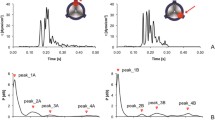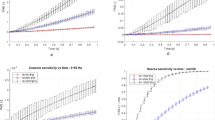Abstract
Blood recirculating devices, such as ventricular assist devices and prosthetic heart valves, are burdened by thromboembolic complications requiring complex and lifelong anticoagulant therapy with its inherent hemorrhagic risks. Pathologic flow patterns occurring in such devices chronically activate platelets, and the optimization of their thrombogenic performance requires the development of flow-induced platelet activation models. However, existing models are based on empirical correlations using the well-established power law paradigm of constant levels of shear stress during certain exposure times as factors for mechanical platelet activation. These models are limited by their range of application and do not account for other relevant phenomena, such as loading rate dependence and platelet sensitization to high stress conditions, which characterize the dynamic flow conditions in devices. These limitations were addressed by developing a new class of phenomenological stress-induced platelet activation models that specifies the rate of platelet activation as a function of the entire stress history and results in a differential equation that can be directly integrated to calculate the cumulative levels of activation. The proposed model reverts to the power law under constant shear stress conditions and is able to describe experimental results in response to a diverse range of highly dynamic stress conditions found in blood recirculating devices. The model was tested in vitro under emulated device flow conditions and correlates well with experimental results. This new model provides a reliable and robust mathematical tool that can be incorporated into computational fluid dynamic studies in order to optimize design, with the goal of improving the thrombogenic performance of blood recirculating devices.







Similar content being viewed by others
References
Alemu Y, Bluestein D (2007) Flow-induced platelet activation and damage accumulation in a mechanical heart valve: numerical studies. Artif Organs 31(9):677–688
Alemu Y, Girdhar G, Xenos M, Sheriff J, Jesty J, Einav S, Bluestein D (2010) Design optimization of a mechanical heart valve for reducing valve thrombogenicity–a case study with ats valve. ASAIO J 56(5):389–396
Apel J, Paul R, Klaus S, Siess T, Reul H (2001) Assessment of hemolysis related quantities in a microaxial blood pump by computational fluid dynamics. Artif Organs 25(5):341–347
Blackshear PL, Dorman FD, Steinbach JH (1965) Some mechanical effects that influence hemolysis. Trans Am Soc Artif Int Organs 11:112–117
Bludszuweit C (1995a) Model for a general mechanical blood damage prediction. Artif Organs 19(7):583–589
Bludszuweit C (1995b) Three-dimensional numerical prediction of stress loading of blood particles in a centrifugal pump. Artif Organs 19(7):590–596
Bluestein D, Chandran KB, Manning KB (2010) Towards non-thrombogenic performance of blood recirculating devices. Ann Biomed Eng 38(3):1236–1256
Bluestein D, Li YM, Krukenkamp IB (2002) Free emboli formation in the wake of bi-leaflet mechanical heart valves and the effects of implantation techniques. J Biomech 35(12):1533–1540
Bluestein D, Niu L, Schoephoerster RT, Dewanjee MK (1997) Fluid mechanics of arterial stenosis: relationship to the development of mural thrombus. Ann Biomed Eng 25(2):344–356
Boreda R, Fatemi RS, Rittgers SE (1995) Potential for platelet stimulation in critically stenosed carotid and coronary arteries. J Vasc Inv 1:26–37
Butchart EG, Lewis PA, Grunkemeier GL, Kulatilake N, Breckenridge IM (1988) Low risk of thrombosis and serious embolic events despite low-intensity anticoagulation. Experience with 1,004 medtronic hall valves. Circulation 78(3 Pt 2):I66–I77
Cheng R, Lai YG, Chandran KB (2004) Three-dimensional fluid-structure interaction simulation of bileaflet mechanical heart valve flow dynamics. Ann Biomed Eng 32(11):1471–1483
Claiborne TE, Girdhar G, Gallocher-Lowe S, Sheriff J, Kato YP, Pinchuk L, Schoephoerster RT, Jesty J, Bluestein D (2011) Thrombogenic potential of innovia polymer valves versus carpentier-edwards perimount magna aortic bioprosthetic valves. ASAIO J 57(1):26–31
Dumont K, Vierendeels J, Kaminsky R, Van Nooten G, Verdonck P, Bluestein D (2007) Comparison of the hemodynamic and thrombogenic performance of two bileaflet mechanical heart valves using a cfd/fsi model. J Biomech Eng-T ASME 129(4):558–565
Edmunds LH Jr (1987) Thrombotic and bleeding complications of prosthetic heart valves. Ann Thorac Surg 44(4):430–445
Einav S, Dewey CF, Hartenbaum H (1994) Cone-and-plate apparatus–a compact system for studying well-characterized turbulent-flow fields. Exp Fluids 16(3–4):196–202
Giersiepen M, Wurzinger LJ, Opitz R, Reul H (1990) Estimation of shear stress-related blood damage in heart-valve prostheses–in vitro comparison of 25 aortic valves. Int J Artif Organs 13(5):300–306
Girdhar G, Bluestein D (2008) Biological effects of dynamic shear stress in cardiovascular pathologies and devices. Expert Rev Med Devices 5(2):167–181
Girdhar G, Xenos M, Alemu Y, Chiu WC, Lynch BE, Jesty J, Einav S, Slepian MJ, Bluestein D (2012) Device thrombogenicity emulation: a novel method for optimizing mechanical circulatory support device thromboresistance. PLoS One 7(3):e32463
Goldstein DJ (2003) Worldwide experience with the micromed debakey ventricular assist device (r) as a bridge to transplantation. Circulation 108(10):272–277
Goubergrits L, Affeld K (2004) Numerical estimation of blood damage in artificial organs. Artif Organs 28(5):499–507
Grigioni M, Daniele C, Morbiducci U, D’Avenio G, Benedetto GD, Barbaro V (2004) The power-law mathematical model for blood damage prediction: analytical developments and physical inconsistencies, Artif Organs 28(5):467–475
Grigioni M, Morbiducci U, D’Avenio G, Benedetto GD, Gaudio CD (2005) A novel formulation for blood trauma prediction by a modified power-law mathematical model. Biomech Model Mechanobiol 4(4):249–260
Healy TM, Ellis JT, Fontaine AA, Jarrett CA, Yoganathan AP (1997) An automated method for analysis and visualization of laser doppler velocimetry data. Ann Biomed Eng 25(2):335–343
Hellums JD (1994) 1993 whitaker lecture: biorheology in thrombosis research. Ann Biomed Eng 22(5):445–455
Hellums JD, Peterson DM, Stathopoulos NA, Moake JL, Giorgio TD (1987) Studies on the mechanisms of shear-induced platelet activation. In: Hartman A, Kuschinsky W (eds) Cerebral ischemia and hemorheology. Springer, New York, pp 80–89
Jesty J, Bluestein D (1999) Acetylated prothrombin as a substrate in the measurement of the procoagulant activity of platelets: elimination of the feedback activation of platelets by thrombin. Anal Biochem 272(1):64–70
Jesty J, Yin W, Perrotta P, Bluestein D (2003) Platelet activation in a circulating flow loop: combined effects of shear stress and exposure time. Platelets 14(3):143–149
Kincaid D, Cheney EW (2009) Numerical analysis : mathematics of scientific computing. The sally series, vol 2, 3rd edn. American Mathematical Society, Providence, RI
Kini V, Bachmann C, Fontaine A, Deutsch S, Tarbell JM (2001) Integrating particle image velocimetry and laser doppler velocimetry measurements of the regurgitant flow field past mechanical heart valves. Artif Organs 25(2):136–145
Kroll MH, Hellums JD, McIntire LV, Schafer AI, Moake JL (1996) Platelets and shear stress. Blood 88(5):1525–1541
Leverett LB, Hellums JD, Alfrey CP, Lynch EC (1972) Red blood cell damage by shear stress. Biophys J 12(3):257–273
Merten M, Chow T, Hellums JD, Thiagarajan P (2000) A new role for p-selectin in shear-induced platelet aggregation. Circulation 102(17):2045–2050
Morbiducci U, Ponzini R, Nobili M, Massai D, Montevecchi FM, Bluestein D, Redaelli A (2009) Blood damage safety of prosthetic heart valves. Shear-induced platelet activation and local flow dynamics: a fluid-structure interaction approach. J Biomech 42(12):1952–1960
Nobili M, Sheriff J, Morbiducci U, Redaelli A, Bluestein D (2008) Platelet activation due to hemodynamic shear stresses: damage accumulation model and comparison to in vitro measurements. ASAIO J 54(1):64–72
Odibat ZM, Shawagfeh NT (2007) Generalized taylor’s formula. Appl Math Comput 186(1):286–293
Purvis NB Jr, Giorgio TD (1991) The effects of elongational stress exposure on the activation and aggregation of blood platelets. Biorheology 28(5):355–367
Ramachandran J, Rubenstein D, Bluestein D, Jesty J (2004) Activation of platelets exposed to shear stress in the presence of smoke extracts of low-nicotine and zero-nicotine cigarettes: the protective effect of nicotine. Nicotine Tob Res 6(5):835–841
Ramstack JM, Zuckerman L, Mockros LF (1979) Shear-induced activation of platelets. J Biomech 12(2):113–125
Schulz-Heik K, Ramachandran J, Bluestein D, Jesty J (2005) The extent of platelet activation under shear depends on platelet count: differential expression of anionic phospholipid and factor va. Pathophysiol Haemost Thromb 34(6):255–262
Sheriff J (2010) Shear-induced platelet sensitization and the development of an activation model. Stony Brook University, Stony Brook
Sheriff J, Bluestein D, Girdhar G, Jesty J (2010) High-shear stress sensitizes platelets to subsequent low-shear conditions. Ann Biomed Eng 38(4):1442–1450
Song X, Throckmorton AL, Wood HG, Antaki JF, Olsen DB (2003) Computational fluid dynamics prediction of blood damage in a centrifugal pump. Artif Organs 27(10):938–941
Sutera SP, Nowak MD, Joist JH, Zeffren DJ, Bauman JE (1988) A programmable, computer-controlled cone-plate viscometer for the application of pulsatile shear stress to platelet suspensions. Biorheology 25(3):449–459
Tambasco M, Steinman DA (2003) Path-dependent hemodynamics of the stenosed carotid bifurcation. Ann Biomed Eng 31(9):1054–1065
Travis BR, Marzec UM, Ellis JT, Davoodi P, Momin T, Hanson SR, Harker LA, Yoganathan AP (2001) The sensitivity of indicators of thrombosis initiation to a bileaflet prosthesis leakage stimulus. J Heart Valve Dis 10(2):228–238
Wilhelm CR, Ristich J, Knepper LE, Holubkov R, Wisniewski SR, Kormos RL, Wagner WR (1999) Measurement of hemostatic indexes in conjunction with transcranial doppler sonography in patients with ventricular assist devices. Stroke 30(12):2554–2561
Wu J, Antaki JF, Snyder TA, Wagner WR, Borovetz HS, Paden BE (2005) Design optimization of blood shearing instrument by computational fluid dynamics. Artif Organs 29(6):482–489
Wu J, Paden BE, Borovetz HS, Antaki JF (2010) Computational fluid dynamics analysis of blade tip clearances on hemodynamic performance and blood damage in a centrifugal ventricular assist device. Artif Organs 34(5):402–411
Wurzinger LJ, Opitz R, Blasberg P, Schmid-Schonbein H (1985) Platelet and coagulation parameters following millisecond exposure to laminar shear stress. Thromb Haemost 54(2):381–386
Xenos M, Girdhar G, Alemu Y, Jesty J, Slepian M, Einav S, Bluestein D (2010) Device thrombogenicity emulator (dte)-design optimization methodology for cardiovascular devices: a study in two bileaflet MHV designs. J Biomech 43(12):2400–2409
Yeleswarapu KK, Antaki JF, Kameneva MV, Rajagopal KR (1995) A mathematical model for shear-induced hemolysis. Artif Organs 19(7):576–582
Yin W, Alemu Y, Affeld K, Jesty J, Bluestein D (2004) Flow-induced platelet activation in bileaflet and monoleaflet mechanical heart valves. Ann Biomed Eng 32(8):1058–1066
Yin W, Gallocher S, Pinchuk L, Schoephoerster RT, Jesty J, Bluestein D (2005) Flow-induced platelet activation in a st. Jude mechanical heart valve, a trileaflet polymeric heart valve, and a St. Jude tissue valve. Artif Organs 29(10):826–831
Yoganathan AP, He Z, Casey Jones S (2004) Fluid mechanics of heart valves. Annu Rev Biomed Eng 6:331–362
Yun BM, Wu J, Simon HA, Arjunon S, Sotiropoulos F, Aidun CK, Yoganathan AP (2012) A numerical investigation of blood damage in the hinge area of aortic bileaflet mechanical heart valves during the leakage phase. Ann Biomed Eng 40(7):1468–1485
Zhang JN, Bergeron AL, Yu Q, Sun C, McIntire LV, Lopez JA, Dong JF (2002) Platelet aggregation and activation under complex patterns of shear stress. Thromb Haemost 88(5):817–821
Zhang JN, Bergeron AL, Yu QH, Sun C, McBride L, Bray PF, Dong JF (2003) Duration of exposure to high fluid shear stress is critical in shear-induced platelet activation-aggregation. Thromb Haemost 90(4):672–678
Acknowledgments
The authors thank Dr. Joylon Jesty for insightful discussions and acknowledge support from the National Institute of Biomedical Imaging and Bioengineering division of the National Institutes of Health: Quantum Award Phase I R01, EB008004-03 (DB), and Quantum Award: Implementation Phase II-5U01EB012487-02 (DB).
Author information
Authors and Affiliations
Corresponding author
Rights and permissions
About this article
Cite this article
Soares, J.S., Sheriff, J. & Bluestein, D. A novel mathematical model of activation and sensitization of platelets subjected to dynamic stress histories. Biomech Model Mechanobiol 12, 1127–1141 (2013). https://doi.org/10.1007/s10237-013-0469-0
Received:
Accepted:
Published:
Issue Date:
DOI: https://doi.org/10.1007/s10237-013-0469-0




